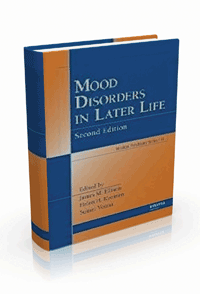Article
Mood Disorders in Later Life, 2nd ed
Author(s):
This text provides an excellent overview of mood disorders during older adulthood. Chapter 1 deals with diagnosis and includes helpful diagnostic tools and pertinent laboratory values. Chapter 2 addresses nonmajor depressive syndromes-a much-needed area of discussion-and provides a literature review in an easy-to-read table. Chapter 3 includes very good information about epidemiology and a most useful table of information. Another strength is a discussion of potential reasons for low rates of depressive disorders.
This text provides an excellent overview of mood disorders during older adulthood. Chapter 1 deals with diagnosis and includes helpful diagnostic tools and pertinent laboratory values. Chapter 2 addresses nonmajor depressive syndromes-a much-needed area of discussion-and provides a literature review in an easy-to-read table. Chapter 3 includes very good information about epidemiology and a most useful table of information. Another strength is a discussion of potential reasons for low rates of depressive disorders.
Noteworthy features in chapter 4 on bipolar disorders are a case study, a description of geriatric mania, and a table of diagnostic considerations. Chapter 5 deals with treatment barriers-a much-needed area of information for practitioners. Chapter 6 expounds on an important and perhaps less discussed area-the economic burden of late-life depression. Late-life suicide is covered in chapter 7, in which there are informative statistics. Further clinical recommendations might be helpful, perhaps condensed into a Table.
Chapter 8 on neurobiological aspects is informative and comprehensive without being too advanced for the nonspecialist. Chapter 9 addresses depression and dementia, a complicated mix of disease processes. One strong point is the mention of the heterogeneity of depression in the geriatric population, as well as the differences and interface between the two.
Chapter 10 is an informative discussion of vascular depression. Mood disorders and medical illness are addressed in chapter 11; the table of conditions is quite relevant and helpful, although it might be useful to also cover cerebrovascular disease and its relationship to mood disorders. A strength of chapter 12, which deals with substance use, is the case vignette. Perhaps inclusion of a clinical vignette for each chapter would have enhanced the text.
Chapter 13 discusses cultural issues. This content is particularly valuable, since our older adult population is rapidly increasing in diversity. There is an excellent breakdown of various racial and ethnic groups, including pharmacological information. This chapter is a particularly strong one.
Bereavement is covered in chapter 14; the clinical recommendations are helpful, and this is more information on bereavement than I have seen in many other similar sources. Pharmacotherapy is the topic of chapter 15; tables with thorough evidence-based practice and clinical recommendations are included. Acute and continuous-phase care are particularly important and a wise inclusion. This is a thorough yet concise chapter.
Neurotherapeutic treatments are discussed in chapter 16; content dealing with effects of ECT on each system is quite helpful. Relevant and useful clinical guidelines are included. Chapter 17 discusses psychotherapy barriers; this is a plus. The gerotherapist section is especially valuable to readers’ understanding. Inclusion of a clinical vignette and content on personality disorders and cognitive impairment are also strengths. Chapter 18 addresses medication nonadherence; it is particularly well organized. Chapter 19 recognizes a very important subgroup: the vulnerable elderly. Overall, the text is quite relevant and contains current, accurate, and much-needed information for the practitioner.







